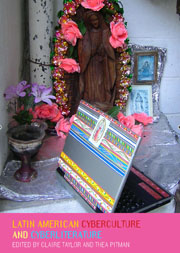Book contents
- Frontmatter
- Contents
- List of Illustrations
- Acknowledgements
- Foreword: Latin American Cyberliterature: From the Lettered City to the Creativity of its Citizens
- Notes on Contributors
- Introduction
- I Cyberculture and Cybercommunities
- 1 The New New Latin American Cinema: Cortometrajes on the Internet
- 2 Cyborgs, Cities, and Celluloid: Memory Machines in Two Latin American Cyborg Films
- 3 The Cyberart of Corpos Informáticos
- 4 Latin American Cyberprotest: Before and After the Zapatistas
- 5 Body, Nation, and Identity: Guillermo Gómez-Peña's Performances on the Web
- 6 Cyberspace Neighbourhood: The Virtual Construction of Capão Redondo
- 7 Literary E-magazines in Latin America: From Textual Criticism to Virtual Communities
- 8 Negotiating a (Border Literary) Community Online en la línea
- II Cyberliterature: Avatars and Aficionados
- A Cyberliterary Afterword: Of Blogs and Other Matters
- Conclusion: Latin American Identity and Cyberspace
- Suggested Further Reading
- Index
1 - The New New Latin American Cinema: Cortometrajes on the Internet
from I - Cyberculture and Cybercommunities
- Frontmatter
- Contents
- List of Illustrations
- Acknowledgements
- Foreword: Latin American Cyberliterature: From the Lettered City to the Creativity of its Citizens
- Notes on Contributors
- Introduction
- I Cyberculture and Cybercommunities
- 1 The New New Latin American Cinema: Cortometrajes on the Internet
- 2 Cyborgs, Cities, and Celluloid: Memory Machines in Two Latin American Cyborg Films
- 3 The Cyberart of Corpos Informáticos
- 4 Latin American Cyberprotest: Before and After the Zapatistas
- 5 Body, Nation, and Identity: Guillermo Gómez-Peña's Performances on the Web
- 6 Cyberspace Neighbourhood: The Virtual Construction of Capão Redondo
- 7 Literary E-magazines in Latin America: From Textual Criticism to Virtual Communities
- 8 Negotiating a (Border Literary) Community Online en la línea
- II Cyberliterature: Avatars and Aficionados
- A Cyberliterary Afterword: Of Blogs and Other Matters
- Conclusion: Latin American Identity and Cyberspace
- Suggested Further Reading
- Index
Summary
Two years ago, when I first became interested in the phenomenon of Internet video in the Spanish-speaking world, I was able to locate over a thousand sites including articles and video projection and download sites – a large, but still manageable number. In August 2005, there were 265,000; a quick check in October turned up 700,000 (of which 18,000 were download sites). Even taking into account the vast amounts of duplication on mirror sites, I would be reluctant even to guess at the range of discrete locations that will appear by the time this chapter sees print. The well-known US-based site Atomfilms/Shockwave at that time reported an archive of over 15,000 films and a visitor base of over 20 million per month. Ifilm, in its ‘success stories’ link, bragged about its growing importance to industry heavyweights as evidenced by the on- and offline deals with filmmakers that the site had generated. Buscacine was offering hyperlinked pages on filmmakers, cortometrajes, and even updates on unreleased cortos still in production stages. The Argentine site SoloCortos expressed its mission in an email bulletin dated 30 September 2005 as ‘to generate attention about the new creative Latin American audiovisual currents, which, thanks to the digital era, have offered greater and richer possibilities for expression to more artists, without discrimination by country, resources, and sex’.
- Type
- Chapter
- Information
- Latin American Cyberculture and Cyberliterature , pp. 33 - 49Publisher: Liverpool University PressPrint publication year: 2007



